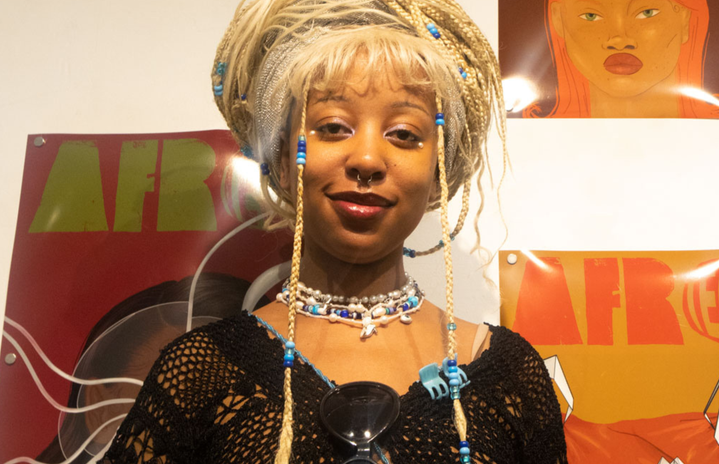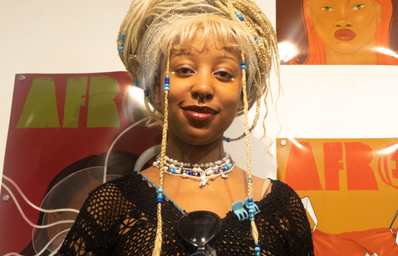Gallery 1265 at UofT Scarborough campus highlights student Makena Mwenda’s work for black history month.
Her campus media writer Muzna sits down with Makena Mwenda on her exhibition AFROTECH.
For fourth-year student Makena Mwenda majoring in public policy and minoring in studio arts, journey in arts has been something she has self-taught and learned on her own. Crafting her own skills in the art space in high school in the medium of digital arts and animation – it’s been Wanda’s way to communicate her thoughts and feelings and to express her self-identity growing up in two different worlds, Kenya and Canada.
In her exhibition, AFROTECH, hosted by the 1265 Gallery at the University of Toronto, Scarborough, for black history month, Mwenda focused on using stop animations with over 500 frames to explore hair in an Afrofuturism world. Her pieces include inspiration from Wes Anderson’s colour theory and Jordan Peel’s centring of Black Lives.
But wait, before you read on, what is Afrofuturism?
Afrofuturism was a term coined by critical scholar Mark Dery in 1993 In his essay “Black to the Future.” The ideology of Afrofuturism reimagines the history of black futures – past, present and future free from the bondage of violent oppression, colonialism, white supremacist thoughts and structures, leaving the Black community to reclaim liberation, thrive in their own culture, especially modern technology-wise.
Muzna: Can you start by explaining how you got into the digital and visual arts world?
Mwenda: “I’ve always been an artist; I think it’s been something that is innate. So, drawing, and just like visuals, have always inspired me as a way to communicate. I started with painting and in more of the physical field, and then in high school, I learned Illustrator. In university, in my first year, I got introduced to the Varsity through their Black History Month issue, and since then, I’ve been contributing illustrations. I’m self-taught, for the most part; I’ve taught myself, Illustrator, Photoshop, and InDesign – all the things that I’ve used, especially for this gallery, like watching YouTube and teaching myself.”
Muzna: What inspired you to create these pieces for the exhibition, and what did you hope the audience would take out from the collection you created?
Mwenda: “Afrofuturism has been in my art for a while now because I grew up partially in Kenya and partly my life in Canada. That international experience has shaped my art. I love to imagine a world without colonialism and its effects [with] black liberation, happiness, and joy. I love depicting in my art, so I’ve been doing that for a while [and] I just wanted to push it further because I’ve mostly been doing it with still animations. I thought a way to push it further was to start with animations. I also [am] very interested in hair and braiding. I love doing my own hair [and] love doing other people’s hair, so it was a cool way to integrate all my personal likes, which is like Afrofuturism and hair. My audience, my goal was to inspire black people in my audience. When I was creating these works, I felt my audience was, and always has been, black people for my art to inspire them to reach for happiness and independence. To look into the future and see and be inspired by. It was [created] within a pension, especially for Black History Month, to spark joy and black people’s lives”.
Muzna: How did Wes Anderson’s colour theory and how Jordan Peels centring on Black Lives inspire your pieces?
Mwenda: “Jordan Peele inspired my art by sending us black voices, giving them such personalities and individual characters. And that’s what I wanted from my characters: I wanted each person to feel whole because [many] times when black people are depicted in the media, it’s very one-dimensional. So, [with] each character I developed a personality for them and their character and background. Even with that one still, or just like the series of short animations, you could feel a personality through their hair and what they look like. Wes Anderson, I really like his movie The Grand Budapest Hotel. I watched it on the plane on my way back to Canada from Kenya, and I love the colours used in each scene, with the colour directly relating to the story that was happening. So I wanted to use that, in the sense that I [choose] very few colours, and sticking to them for each piece and making them stand out and reflect the character as well.”
Muzna: How long did it take you to create some of these pieces and frames? And what was that process?
Mwenda: “I started this project last summer, like May. I decided to learn how to animate, so this was my first entrance to animation. It is [it took] eight hours in total [for some pieces]; it ranges, some of them [took] a bit shorter. I did [all the pieces] over quite a few months. [However] it wasn’t even about the length of time it took to make them. It was also about the length of time it took to inspire the character. Honestly, the idea took more work than the animation and illustration itself. Just like conceptualizing who I wanted them to be and how I wanted their hair to look based on who they were. That took a lot more time and research. It was like sleeping on it and trying to just like have it come to me, which is why it took six or seven more next, but each animation took about eight hours from start to finish.
Muzna: What was your favourite piece from the collection? How long did it take you to conceptualize the character?
Mwenda: “My favourite piece is the first one I made for this series. It’s the most inspired; honestly, I love an African headwrap. I love wearing them myself. I’ve been teaching my sister how to put it on, so in the process of all of that, It came to me. I just like I immediately knew what I wanted to do for her.”
Muzna: Could you explain to me some of the characters of your other pieces?
Mwenda: “I mostly durags girls. The boys were definitely the hardest to get, like, get into their minds and get the characters for them. A lot of them are vaguely based on my brother, personality-wise. The locks are based on a guy I met; I channelled his energy with locks. My favourite personality is [the girl with] light-skinned and orange hair. She’s the loudest personality in my mind. Or just like the most vivid personality in my mind, just like this mixed girl with this big red hair. And because she straightened it, that sticks out to me the most. It’s this dichotomy between personal choice and being like, I can straighten my hair because I want to straighten or, am I doing this for someone else? Is this a beauty standard that I’m being drawn into for reasons that aren’t because I want to be in them? I’ve known many l, mixed black people who have had that struggle”.
You can view Makena Mwenda’s AFROTECH pieces on Gallery 1265 website online.


